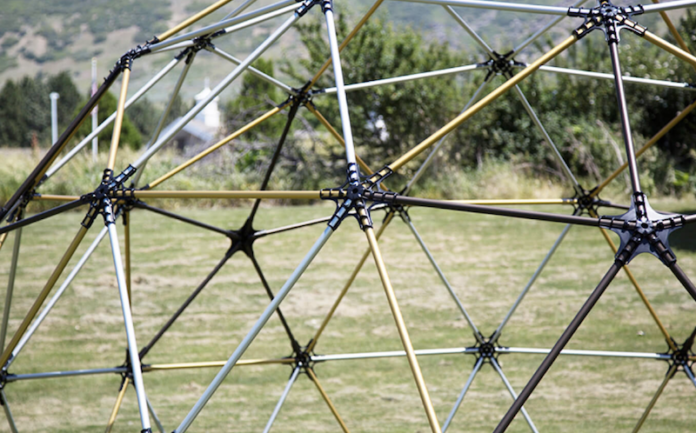A good shelter is one of the most important items when planning for an emergency. The website Ready; the Official website of the Department of Home Security lists shelters as the 2nd thing to plan for in an emergency. While most preppers plan to shelter at home as a first base; they also know having a bug-out destination is always necessary planning. After many disasters; it may be difficult to evacuate because of road damage; flooding; or lack of resources. In these instances; it is important to have a good shelter on hand that is adequate for your climate and family situation.
When researching shelters there are various kinds from army tents; yurts; bunkers and even camping tents. There are pros and cons to each one; but I am here to write about why geodesic shelters (specifically Geo Shelters) are the best shelters to live in after a disaster.
What exactly is a geodesic shelter?
The word geodesic refers to the shortest distance between two points on a curved surface. A geodesic shelter is a dome that is made of half a geodesic sphere. They are usually made from an array of triangles that form this sphere. These spheres enclose a maximum amount of space with the least amount of materials and they don’t require any interior supports.
What are the Benefits of a Geo Shelter?
Geo Shelters have several advantages when compared to conventional emergency shelters or housing. But some of the best benefits are:
- Strength – Most people find it difficult to comprehend the strength of a geodesic dome. The American Institute of Architects say that “The Geodesic Dome is the strongest; lightest and most efficient means of enclosing space yet devised.” The strength of a Geo Shelter comes from the characteristics of the triangles and dome shape. Triangles are the strongest shape because they have a fixed angle and don’t distort very easily. If a pressure is applied to one edge of a triangle; then the force is evenly distributed to the other two sides. A force applied to the corner of a rectangle can deform it into a parallelogram; but the same force will not deform a triangle. Pair the triangles with a dome and you incorporate the strength of the triangles with those of an arch. When many triangles are connected to form a dome; the structure then becomes self-supporting. This means that any pressure applied to the Geo Shelter will be evenly distributed throughout the structure making every part of the structure work against the pressure. That cascading distribution of pressure is how geodesic domes efficiently distribute stress along the entire structure and help eliminate the need for supporting structures. Each connection or hub on a Geo Shelter can support hundreds of pounds of weight.
- Size – Geo Shelters have a 24 foot diameter giving the shelter over 450 square feet of open space. A geometric dome supports itself without needing internal columns or interior load-bearing walls; which gives the shelter more openness.
- Most effective against wind and storms – Unlike square structures that have flat surfaces and corners; Geo Shelters are naturally resistant to the forces of nature because their dome shape allows wind and storms to pass around them. Geodesic domes are especially efficient at shedding snow; rain; and wind. The aerodynamic exterior allows high pressure air to force the dome towards the ground instead of lifting it up and blowing away.
- Maximum solar exposure – A square or rectangle building receive less sun in the morning and evening and more sun at midday. A Geo Shelter receives more direct sunlight throughout the day because the sun follows the shape of the dome. This solar exposure helps to naturally heat the shelter in the winter and allows for more natural light. The shape is also ideal for solar panels to collect energy.
- Air circulation – The spherical design makes the Geo Shelter highly effective at circulating warm or cold air since it can move freely without being trapped by corners. The dome shape also means outside air will flow around the structure instead of forcing its way into the interior.
- Even temperatures – Easy air circulation allows the Geo Shelters to maintain an even temperature. Lack of corners eliminate the cold areas found in square shelters. The surface area of a geodesic dome is less than 40% of a box shaped building that covers the same floor space. Less surface area makes it easier to heat and cool the Geo Shelter and gives less surface area to be exposed to outside temperature fluctuations.
Other benefits include affordability; ease of assembly; energy efficiency; and versatility.
What makes a Geo Shelter different from other shelters?
Geo Shelters are one of the most portable shelters for their size. The frame on the Geo Shelter is made of aerospace grade aluminum giving the structure its strength and integrity while also helping to keep it significantly lighter than its competitors. The base weight of the 24-foot shelter is 211 lbs. and is broken up into 4 bags giving the shelter the ability to be loaded into cars with ease.
Geo Shelters are also made for long term use. The fitted cover is made from an architectural vinyl fabric that is rated to last 5-7 years; 365 days a year under any weather condition. The cover material is UV protected and fire retardant.
One of the great benefits of a Geo Shelter is the ability to customize the shelter to fit your family’s needs. Some of the options are the number of vertical doors; its color (white; tan; or digital camo); or added insulation and stove jack insert. A wide selection of accessories also help customize the shelter. Some of these accessories include vestibules; interior doors; gear lofts; room dividers; screen doors; stoves; solar panels; lighting; and sleeping systems.















![How to Survive a Street Fight [Videos Inside]](https://www.dailypreppernews.com/wp-content/uploads/2019/06/unnamed-file-1-696x522-218x150.jpg)





